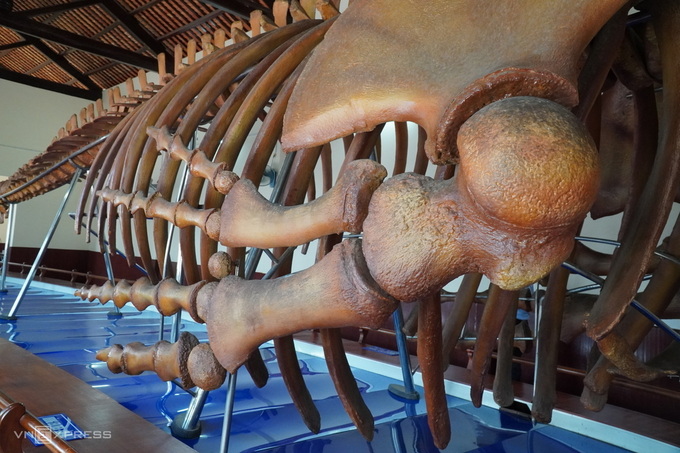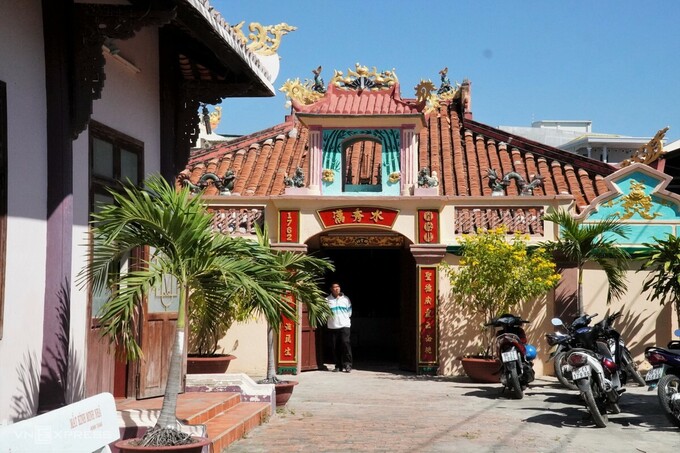5 places to keep whale bones in Vietnam
The large whales in trouble at sea, when washed ashore, are picked up by fishermen, and the skeletons are
BINH THUAN – Whale skeleton more than 20 meters long is on display at the Van Thuy Tu relic (Phan Thiet City) for visitors to visit and research.
Van Thuy Tu is located on Ngu Ong street, Duc Thang ward, about 150 meters from Phan Thiet fishing port. On weekends, this relic attracts many groups of tourists to visit.
On the morning of March 6, Mr. Pham Van Thanh (52 years old, Ho Chi Minh City) and a group of 30 people who were resting in Mui Ne stopped in the thousand. The delegation chose this relic first, because according to Mr. Thanh, people want to understand the culture of the sea before going to entertainment. In particular, it has the largest whale skeleton in the country, causing curiosity.
After 20 minutes of visiting and taking pictures, the members of the delegation were very interested and thought that it was very helpful to come here. “The old architecture was so beautiful, and I did not expect to have such a large whale skeleton,” said Le Thu, 31 years old, walking in the delegation.
Vo Ngoc Nguyen Chau, a narrator at the exhibition area, said the old legend said that in the 18th century, after the construction of the ten thousand throne, there was a Ong fish (the honorable call of the sea people to whales). Very big, drifted ashore before ten thousand. Villagers were mobilized to join forces to bring Ong’s body in.
Because he was too big (estimated to be 22 m long, weighs 65 tons), it was not until two days later that he was able to pull ashore. In addition, the elders had to demolish the front gate of the thousandth throne to bring his body through, and enter the funeral on the grounds to hold a funeral ceremony.
According to the narrator, 3 years later, when the body decomposes, his remains are picked up, washed with water and spirits, then sometimes in the back of the hall of thousands to worship, the incense of smoke every day, preserved integrity over time.
In 2003, the People’s Committee of Phan Thiet City invested a budget for experts to restore and reassemble the skeleton in order to display and introduce it to the public. In 2025, the Vietnam Record of Records established this as the largest whale skeleton in Vietnam.
According to the document of Phan Thiet City Culture and Information Office (2003, compiled by Dao Tan Ho, Nha Trang Institute of Oceanography), based on the characteristics of the existing skeleton, it can be determined here. Gray-backed Whale, scientific name is Balaenoptera physalus .
This fish has 63 vertebrae on the spine arranged in order: 7 vertebrae, 15 vertebrae, 14-6 vertebrae, and 25-27 caudal vertebrae. Along with that are 15 pairs of ribs, 2 bones of the limbs.
The skeleton of the skeleton on display is up to 2.4 m wide. The maxilla (calculated from the skull) is 3.1 m long, viewed from above and has a V-shaped shape. The lower jaw is 3.8 m long. The seven cervical vertebrae have the first pair of bones that are fastened together.
“On the weekend, hundreds of tourists come here, everyone is curious about this skeleton and asks many Phan Thiet ancestors’ custom of worshiping fish”, Ms. Chau said.
Mr. Huynh Giac, 72 years old, Van Thuy Tu’s Board of Directors said, Duc Thang is one of the oldest coastal villages in Phan Thiet. At the end of the 17th century, following the Nguyen Lords to open the realm to the South, groups of immigrants from Tonkin and the area of five Quang (from Phu Yen to Quang Binh) chose the land near the gate of Phan Thiet as a place of business.
In 1762 (Nham Ngo), when life in the new land was stable, the people of Duc Thang contributed and contributed to the creation of the ten thousand pagoda to worship Ong fish, named ten thousand Thuy Tu. “Since the past, he often helped boats to overcome the storms, so our ancestors are very respectful”, Mr. Giac said and said that villagers still keep the customs to this day.
The main hall in the thousand has the altar of the Nam Hai god, the emperor of the clan (the Elephant Gods) and the ancestors of the marine profession. Behind is the worshiping house to preserve more than 100 fish bones He arranged in layers. In it, dozens of large skeletons dating back over 200 years.
In the precinct of thousands of ancient times, there is a large area of land to bury the body of Ong, called “Holy Land”, on the left. Currently, there are 3 tombs that have not yet been lifted.
According to custom, whenever he fishes Ong Wei, villagers have to go ashore to organize a funeral. The first discoverer is called his “eldest son” and mourns like his father. “After 3 years, his bones were brought up by Thuong to be worshiped”, said Mr. Giac.
Previously, most of the dead fish of both big and small were buried in the Holy Land. But now due to the dense population, to avoid environmental pollution, the big men (longer than 3 m in size) are buried in sandy beaches far from residential areas.
Over the past 250 years, thousands of Thuy Tu still maintain traditional festivals, such as spring sacrifice, the summer of the Southern fish crop, the fishing ceremony and the fullness of the Southern fish season … Of which, the biggest one is the fishing festival ( June 20th of lunar calendar). In addition to the solemn ceremony, there are also singing and singing ba trao singing to create a joyful atmosphere for the villagers.
Along with the fish bones of Ong, ten thousand Thuy Tu, there are still many artifacts and works of art typical for the art of wood carving, bronze casting and statues of ancient artisans. Ancient bronze bells, terracotta statues, worship, incense, diaphragm, tales, ordination … still exist with both artistic and historical value.
With unique values still preserved, in 1996, thousands Thuy Tu was recognized by the Ministry of Culture and Information as a national architectural monument. The ten thousand Thuy Tu fishing festival is also included in the list of the national intangible cultural heritage, in 2019.
Follow vnexpress


